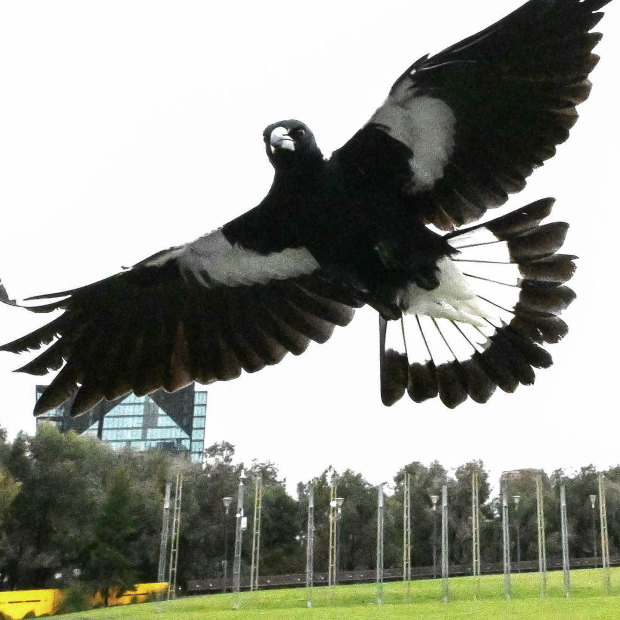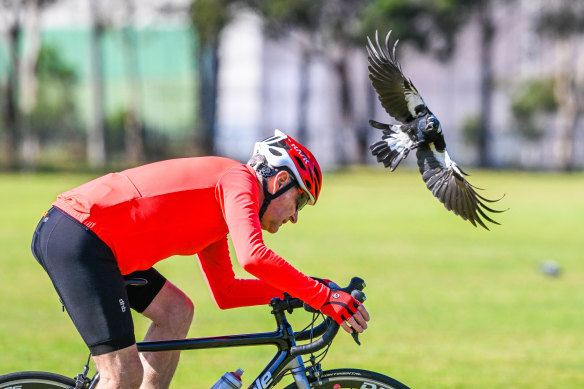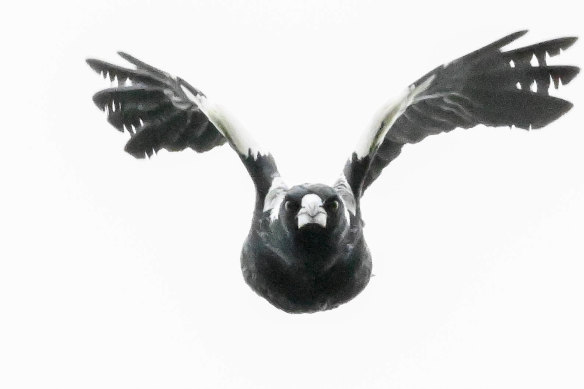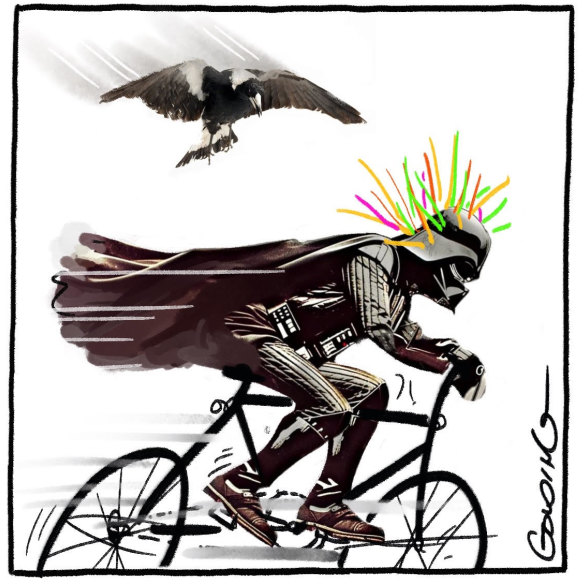This was published 3 months ago
Melbourne’s magpie hotspots: Where you are most likely to get swooped
By Tom Cowie and Craig Butt

Magpies swoop to protect their nests.Credit: Joe Armao
The thing about being swooped by a magpie is that by the time you realise it’s happening, it’s almost certainly too late.
Often, the attack comes from behind, the magpie zeroing in on the back of an unsuspecting person’s head as they glide down from the trees.
The sound of rushing wings arrives moments before impact. The only thing to hope for at that point is a near miss. If it isn’t, then ouch!
Aside from donning full protective gear, which is one way to avoid a beak to the noggin, it’s best to know where not to go to avoid a swooping during spring.
The Age has obtained location data for almost 5000 swooping reports made to Wildlife Victoria over the past five years and analysed it to determine Melbourne’s top 10 locations for avian attacks.
Not all were magpies, some other culprits such as magpie-larks, masked lapwings and grey butcherbirds made the list. But magpies were responsible for the vast majority of swooping reports.

Keith Burbridge is swooped by a magpie at Ormond Park, Moonee Ponds.Credit: Joe Armao
The top location for swoops overall was the 18-hectare expanse of Chelsea Bicentennial Park in Chelsea, in Melbourne’s south-east. More than 30 incidents were reported there, almost half of them within the children’s playground.
Other parks or reserves that made the list were Alma Park in St Kilda East, Point Ormond Reserve in Elwood and Boeing Reserve in Strathmore Heights.
Five of the top 10 locations for swoopings were sections of bike paths or walking trails, the worst being a 150-metre section of the Moonee Ponds Creek Trail, sandwiched between Holbrook Reserve and Ormond Park.
This area had the highest density of reports in the state – and is so notorious that someone has added a place mark for “The World’s Most Aggressive Magpie” at the location in Google Maps.
Another swoop tracking website, Magpie Alert, shows the magpies in that location are particularly prolific, often leading to injuries.
Keith Burbridge, 72, knows this part of the world well. He rides his bike along the trail and has been swooped several times by a magpie that nests in the surrounding trees.
He says the bird sits at a corner of the trail near the Moonee Ponds Bowls Club and will chase cyclists as they head towards the city, sometimes following them underneath the City Link overpass.
Magpies can live for a long time – up to 20 years – and Burbridge reckons it is the same bird swooping year after year.

It’s magpie swooping season at Birrarung Marr.Credit: Joe Armao
“He got me pretty bad one time, and the other time he got both ears,” he said. “I came home and I had chunks out of my ears and blood on my shoulders. So, yes, he’s quite aggressive.”
Burbridge said he had started using a different route during spring to avoid being swooped.
“He’s attacked quite a lot of people, there must be a nest nearby,” he said.
“I’m not sure why there isn’t a sign warning people.”
Skye Primary School, in Melbourne’s south-east, was the only school to make the top 10, with more than half of the reports recorded during February of last year.
The data is based on people reporting swooping to Wildlife Victoria using a crowdsourced map on its website. Most incidents likely go unreported, while some people may disproportionately make submissions.
The data also yielded a few other curious findings:
- A double-magpie swooping in the middle of Albert Park Lake – perhaps the victim was a kayaker.
- A magpie swooping in the trees in the deep rough on the first hole of Northern Golf Club in Glenroy, which would have been a miserable start to someone’s round.
- A magpie swooping on Swan Street Bridge, not far from the AFL Magpies’ main territory – the Collingwood Football Club’s headquarters at Olympic Park.
- A gang of 30 magpies causing trouble in Buckley Park in Essendon, which would have been like a Hitchcock film (and the Magpies were deep in Bombers’ territory).
Among the state’s birdlife, magpies were by far the biggest culprit for swooping, although there were two reports of kookaburras going on the attack in Knoxfield and at Baw Baw National Park.
The bird species was left unspecified in about 5 per cent of reports, possibly because the avian aggressor was too swift to be identified.

Credit: Matt Golding
It may feel like every magpie is a potential threat, but Dr Meg Edwards, lecturer in wildlife science at the University of Southern Queensland, said that only about 10 per cent of males swoop during spring.
She said the magpies were protecting their chicks from perceived predators, in this case walkers, joggers and cyclists.
“It’s usually just a defence mechanism. So it’s them wanting to tell us to stay away from their nest and their eggs,” she said.
“They’ll often do a warning swoop first, where they don’t necessarily make contact. And if we basically don’t heed their advice, then they can do another swoop or two.”
As for preventative measures to avoid being swooped, Edwards said things such as zip ties on helmets and eyes on the back of hats had mixed results.
Running away or screaming at the magpie could make things worse, she said.
“They don’t know what’s going on, they just see you as a threat,” she said.
“And if you’re screaming and yelling, they might think, ‘Oh my gosh, it’s going to come and steal my nest’.
“Giving them a wide berth for a few weeks is always a good idea.”
Start the day with a summary of the day’s most important and interesting stories, analysis and insights. Sign up for our Morning Edition newsletter.